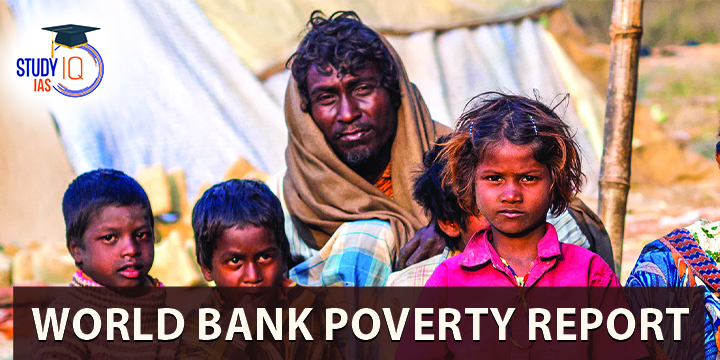Table of Contents
World Bank Poverty Report: Highlights
- Slowing poverty reduction rate: The rate of poverty reduction was slowing since 2015 but the Covid pandemic and the war in Ukraine has reversed the outcomes.
- Poverty reduction has slowed because of subdued global economic growth. At this rate, the global goal of ending extreme poverty by 2030 would not be achieved.
- Increase in extreme poverty: The number of people living below the extreme poverty line rose by over 70 million in 2020. This was the largest one-year increase since start of monitoring of global poverty in 1990.
- Inequality: The income losses of the poorest 40 per cent averaged 4 per cent. It was double the losses of the wealthiest 20 per cent. This resulted in the rise of global inequality.
- Decline in median income: The global median income has declined by 4 per cent in 2020. This was the first decline since measurements of median income began in 1990.
- Learning poverty: Simulations suggests that poverty due to the learning losses will exceed the economic poverty shock for many countries.
- Food inflation: High food price inflation can have detrimental impacts on poorer households, which spend a larger share of their income on food.
- However, for many poor rural households engaged in agriculture, higher food prices can be a source of income growth.
World Bank Poverty Report: Poverty Levels in India
- Based on the US$1.90 poverty line for calculating poverty headcount, the number of poor in India was 13.6 percent. Data from Centre for Monitoring Indian Economy (CMIE) was used for calculation.
- World Bank Poverty Report most recent data on poverty was the 2011/12 National Sample Survey (NSS). The government decided not to release the 2017/18 NSS round as there were concerns about data quality.
- Since India is one of the countries with the biggest poor population, the lack of recent survey data for the country significantly affects the measurement of global poverty.
World Bank Poverty Report: Poverty Estimation in India:
- Individuals or households that fall below a minimum level are designated to be Below the Poverty Line and are considered poor.
- The Poverty Line calculation in India is now carried out by the NITI Aayog based on the data collected by the National Sample Survey Office (NSSO).
World Bank Poverty Report: Committees to Estimate Poverty:
- Dandekar and Rath: The poverty line’s criteria have to be based on spending that would supply 2250 calories per day in both rural and urban areas.
- Alagh committee: The poverty line for rural and urban areas was developed based on nutritional needs and related consumption expenditure.
- Lakdawala committee: The committee suggested consumption expenditure should be calculated based on calorie consumption.
- State specific poverty lines should be constructed using the Consumer Price Index of Industrial Workers (CPI-IW) in urban areas and Consumer Price Index of Agricultural Labour (CPI-AL) in rural areas.
- Tendulkar committee: The committee suggested a shift away from calorie consumption based poverty estimation
- It recommended a uniform poverty line basket (PLB) across rural and urban India
- It suggested a change in the price adjustment procedure to correct spatial and temporal issues with price adjustment
- It suggested that private expenditure on health and education has to be included while estimating poverty.
World Bank Poverty Report: World Bank Suggestions on Fiscal Policy
- Cash transfers must be chosen instead of broad subsidies:
- Cash transfers can help households make crucial long-time investments, such as in educating children.
- Cash transfers can stimulate local economic activity and increase government revenue through indirect taxation.
- Public spending must be prioritized for long-term growth:
- Investments in R&D and some high-value infrastructure can give very high long-run returns.
- Better data are needed to ensure well targeted, high-value fiscal spending. This will ensure that returns are long lasting and higher.
- Tax revenues must be mobilized without hurting the poor:
- Newer forms of progressive taxation, such as property (land, buildings), health (alcohol, tobacco) and carbon (polluting industries) must be introduced to increase tax revenues.
World Bank Poverty Report: Way forward
- Fiscal policy measures: Studies have shown that the average poverty rate in developing economies would have been 2.4 percentage points higher without a fiscal response by the government.
- Fiscal choices made by the governments can act as a lifeline for poor and vulnerable households.
- These measures will help developing economies to step up the fight against poverty and inequality.
- Drawbacks in fiscal measures: Developing economies have fewer resources and therefore spent less and achieved less.
- Upper-middle-income economies were able to offset just 50 per cent of the poverty impact, and low- and lower-middle income economies could offset barely a quarter of the impact.


 Bihu Festival and Dance of Assam, Histor...
Bihu Festival and Dance of Assam, Histor...
 World Heritage Day 2025, Theme, Objectiv...
World Heritage Day 2025, Theme, Objectiv...
 Indian Councils Act 1861, History, Provi...
Indian Councils Act 1861, History, Provi...





















